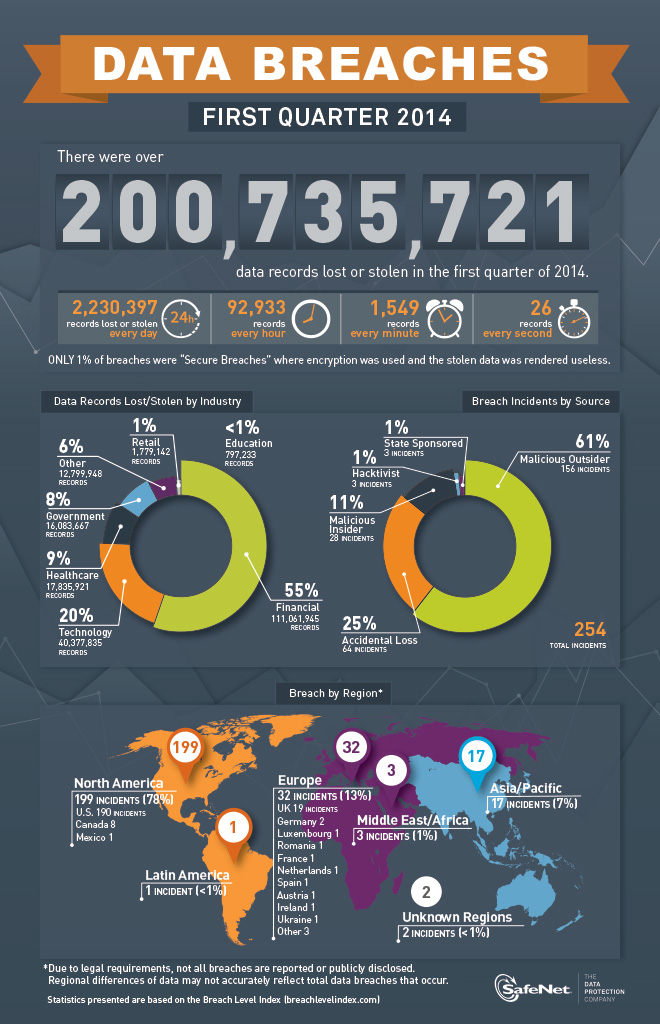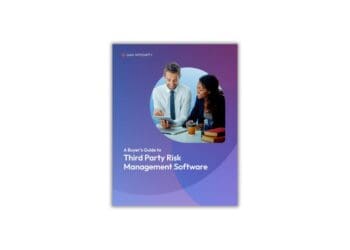233 percent increase over Q1 2013
SafeNet Breach Level Index reveals only 1 percent of 254 Q1 data breaches were “secure breaches” using encryption
Four of the five worst data breaches occurred in South Korea
BALTIMORE – April 29, 2014 ─SafeNet, Inc., a global leader in data protection solutions, today released the highlights from its SafeNet Breach Level Index (BLI) for the first quarter of 2014. Nearly 200 million records were stolen, the equivalent of approximately 93,000 records stolen every hour between January and March, which was an increase of 233 percent over the same time last year. Of the 254 data breaches that occurred during the quarter, only 1 percent were “secure breaches,” or breaches where strong encryption, key management or authentication solutions protected the data from being used.
Q1 Highlights
The Breach Level Index provides details about hundreds of individual data breaches, which can be sorted by source, industry, risk level and date. Highlights from the first quarter research include:
- More than 254 data breaches were publicized, representing 200 million lost or stolen data records. Because of the varying strictness of data breach reporting requirements around the globe, this quarterly data does not include organizations that didn’t disclose the amount of data records that were exposed. In all probability, the total number is likely to be even higher.
- South Korea took the top spot of all countries with four of the top five breaches worldwide and a loss of 158 million records across a variety of industries. This represents 79 percent of the total number of reported breached records worldwide. These four breaches included the Korea Credit Bureau, Korean Medical Association, Korea Telecom and Naver, a major Korean search portal. While the number of South Korean breached records was extremely high, the number of breach incidents in Asia Pacific as a whole accounted for only 7 percent of the total number of global breaches, dwarfed by the 78 percent (199 incidents) that occurred in North America and 13 percent in Europe.
- The financial industry was hit hardest, accounting for 56 percent of all data records lost or stolen. However, it represented 14 percent of total breaches during the quarter.
- The health care industry was hit hard in terms of breach events, accounting for 24 percent of all breaches. However, the industry accounted for just 9 percent of data records lost or stolen.
- Twenty percent of all records lost or stolen came from the technology industry, while retail represented just 1 percent of data records lost or stolen and 10 percent of all data breaches, even including the Sally Beauty Supply breach, which made major headlines.
- Government and education breaches accounted for less than 1 percent of total records stolen and 23 percent of data breaches, including the University of Maryland’s breach of 287,000 records stolen early this year.
- Malicious outsiders accounted for 156 (62 percent) of total incidents during the first quarter, with more than 86 million records stolen. Malicious insiders only accounted for 11 percent of total incidents, but they were much more effective, accounting for 52 percent of records stolen. Accidental loss represented 25 percent of total incidents, while “hacktivist” and state-sponsored attacks added up to only 2 percent of the total.
- There were approximately three breaches and 2.2 million records stolen each day, and more than 92,000 per hour.
- Additional quarterly breakdowns are available in the BLI Executive Summary.
“The white noise of data breach reporting makes every breach seem just as bad as the last, but this is certainly not the case. Some organizations are handling customer data responsibly, and others are not. Tools like the Breach Level Index can help companies and the public alike understand the actual severity of breaches on a graduated scale and distinguish between these two groups,” said Tsion Gonen, Chief Strategy Officer at SafeNet. “In differentiating between secure and insecure breaches, it’s important to look at which victims have protected their data with encryption to limit the damage from a breach and render the date unusable to cyber criminals.”
About the Breach Level Index
The BLI provides a centralized, global database of data breaches and calculates their severity based on multiple dimensions, including the type of data and the number of records stolen, the source of the breach and whether or not the data was encrypted. By assigning a severity score to each breach, the BLI provides a comparative list of breaches, distinguishing nuisances from truly impactful mega breaches. Information populating the BLI database is based on publicly available breach disclosure information.
SafeNet first collaborated with industry analyst firm IT-Harvest in 2013 to develop the logarithmic formula used to determine breach severity. When calculating the severity of data breaches, the BLI factors in multiple inputs, including data type, number of records stolen, breach source and if the high-value data remained secure after the breach was discovered. These inputs are then processed through a proprietary algorithm that produces an index number, with 1 being least severe and 10 being most severe.
Note: Information in the Breach Level Index is collected from public sources. SafeNet provides this information “as-is,” makes no representation or guaranties regarding this information and is not liable for any use. A secure breach is categorized as a breach in which strong encryption, key management and authentication solutions protect the data from being accessed during an attack.
Resources
- The Data Breach Breakdown for Q1 2014 blog post: http://data-protection.safenet-inc.com/2014/04/data-breach-breakdown-report-q1-2014
- Breach Level Index website: www.breachlevelindex.com
- Secure the Breach website: www.securethebreach.com
- Secure the Breach Manifesto: http://www2.safenet-inc.com/securethebreach/downloads/secure_the_breach_manifesto.pdf
- White Paper: Categorizing Data Breach Severity with a Breach Level Index: http://breachlevelindex.com/pdf/Breach-Level-Index-WP.pdf
About SafeNet, Inc.
Founded in 1983, SafeNet, Inc. is one of the largest information security companies in the world and is trusted to protect the most sensitive data for market-leading organizations around the globe. SafeNet’s data-centric approach focuses on the protection of high-value information throughout its life cycle, from the data center to the cloud. More than 25,000 customers across commercial enterprises and government agencies trust SafeNet to protect and control access to sensitive data, manage risk, ensure compliance and secure virtual and cloud environments. Learn more about SafeNet on Twitter, LinkedIn, Facebook, YouTube and Google+.














